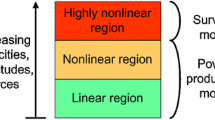Abstract
Latching control is considered to be an effective way to improve the energy absorption of a wave energy converter (WEC). Recently, a latching control method was realized in a hydraulic power take-off (PTO) system and was demonstrated to be effective in one-body WECs. However, the effectiveness of latching control for two-body WECs still needs to be tested. In this paper, a feedback latching controller is proposed for a conceptual two-body WEC. In this conceptual design, a permanent-magnet linear generator (PMLG) is adopted as the PTO system, and a pure water hydraulic cylinder system is designed for performing the latching control. A feedback control strategy based on the measurement of latching force is established, formulated and tested numerically under realistic irregular wave conditions. The effects of the wave peak period and the PTO damping coefficient on the effectiveness of the latching control is also investigated. The results indicate that the proposed feedback latching control is effective for improving the annual power absorption of the two-body WEC. Furthermore, compared to another latching control, the proposed control is more practical because it does not require any knowledge of the wave conditions or the dynamics of the whole WEC system.
Similar content being viewed by others
References
Mavrakos S A. Hydrodynamic coefficients in heave of two concentric surface-piercing truncated circular cylinders. Appl Ocean Res, 2004, 26: 84–97
Falcão A F O, Cândido J J, Justino P A P, et al. Hydrodynamics of the IPS buoy wave energy converter including the effect of non-uniform acceleration tube cross section. Renew Energy, 2012, 41: 105–114
Polinder H, Damen M E C, Gardner F. Linear PM generator system for wave energy conversion in the AWS. IEEE Trans On Energy Convers, 2004, 19: 583–589
Brekken T K, Von Jouanne A, Han H Y. Ocean wave energy overview and research at oregon state university. In: IEEE Power Electronics and Machines in Wind Applications. Lincoln, 2009
Yeung R W, Peiffer A, Tom N, et al. Design, analysis, and evaluation of the UC-Berkeley wave-energy extractor. J Offshore Mech Arct Eng, 2012, 134: 021902
Budal K, Falnes J. Interacting point absorbers with controlled motion. Power Sea Waves, 1980. 381–399
Babarit A, Duclos G, Clément A H. Comparison of latching control strategies for a heaving wave energy device in random sea. Appl Ocean Res, 2004, 26: 227–238
Hoskin R, Nichols N. Optimal strategies for phase control of wave energy devices. In: McCormick M E, Kim Y C, eds. Utilization of Ocean Waves—Wave to Energy Conversion. New York: American Society of Civil Engineers. 1986. 184–199
Falcão A F O. Phase control through load control of oscillating-body wave energy converters with hydraulic PTO system. Ocean Eng, 2008, 35: 358–366
Kara F. Time domain prediction of power absorption from ocean waves with latching control. Renew Energy, 2010, 35: 423–434
Sheng W, Alcorn R, Lewis A. On improving wave energy conversion, part II: Development of latching control technologies. Renew Energy, 2015, 75: 935–944
Budal K, Falnes J, Lillebekke P M, et al. The Norwegian wave-power buoy project. In: The Second International Symposium On Wave Energy Utilization. Trondheim, 1982
Korde U A. Latching control of deep water wave energy devices using an active reference. Ocean Eng, 2002, 29: 1343–1355
Cândido J J, Justino P A P S. Modelling, control and Pontryagin Maximum Principle for a two-body wave energy device. Renew Energy, 2011, 36: 1545–1557
Henriques J C C, Lopes M F P, Gomes R P F, et al. On the annual wave energy absorption by two-body heaving WECs with latching control. Renew Energy, 2012, 45: 31–40
Falnes J. Ocean Waves and Oscillating Systems: Linear Interactions Including Wave-Energy Extraction. Cambridge: Cambridge University Press, 2002
Weiss G, Li G, Mueller M, et al. Optimal control of wave energy converters using deterministic sea wave prediction. In: Fuelling the Future: Advances in Science and Technologies for Energy Generation, Transmission and Storage. London: Brown-Walker Press, 2012. 396
Belmont M R, Horwood J M K, Thurley R W F, et al. Filters for linear sea-wave prediction. Ocean Eng, 2006, 33: 2332–2351
Fusco F, Ringwood J V. A study of the prediction requirements in real-time control of wave energy converters. IEEE Trans Sustain Energy, 2012, 3: 176–184
Li G, Weiss G, Mueller M, et al. Wave energy converter control by wave prediction and dynamic programming. Renew Energy, 2012, 48: 392–403
Scruggs J T, Lattanzio S M, Taflanidis A A, et al. Optimal causal control of a wave energy converter in a random sea. Appl Ocean Res, 2013, 42: 1–15
Fusco F, Ringwood J. Suboptimal causal reactive control of wave energy converters using a second order system model. In: Proceedings of the 21st (2011) International Offshore and Polar Engineering Conference. 2011. 687–694
Price A, Forehand D, Wallace A. Time-span of future information necessary for theoretical acausal optimal control of wave energy converters. In: Accepted invited paper for the European Control Conference. Budapest, 2009
Budar K, Falnes J. A resonant point absorber of ocean-wave power. Nature, 1975, 256: 478–479
Falnes J. Wave-energy conversion through relative motion between two single-mode oscillating bodies. J Offshore Mech Arct Eng, 1999, 121: 32
ANSYS. 2010. AQWA-LINE Manual. United Kingdom: ANSYS, Inc
Tao L, Dray D. Hydrodynamic performance of solid and porous heave plates. Ocean Eng, 2008, 35: 1006–1014
Iuppa C, Cavallaro L, Vicinanza D, et al. Investigation of suitable sites for wave energy converters around Sicily (Italy). Ocean Sci, 2015, 11: 543–557
Author information
Authors and Affiliations
Corresponding author
Rights and permissions
About this article
Cite this article
Liu, K., Wang, D., Qiu, S. et al. A feedback latching controller for two-body wave energy converters under irregular wave conditions. Sci. China Technol. Sci. 61, 1114–1126 (2018). https://doi.org/10.1007/s11431-017-9308-9
Received:
Accepted:
Published:
Issue Date:
DOI: https://doi.org/10.1007/s11431-017-9308-9




